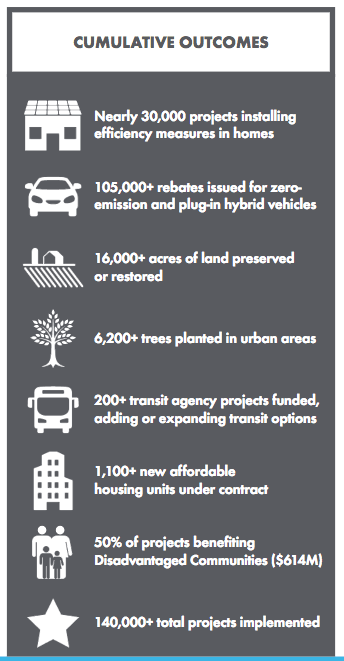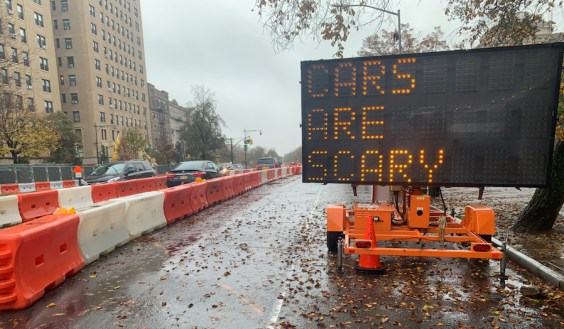The California Air Resources Board just released its annual report on climate change programs that receive cap-and-trade auction funds. The report, required by A.B. 1532, describes what cap-and-trade proceeds are spent on, how much those programs are reducing greenhouse gases, and what other benefits the state is getting.
Since it began allocating funds in 2013, says the report, $1.2 billion in projects have already been implemented, meaning they are already achieving greenhouse gas emissions reductions and benefiting disadvantaged communities, as required by law. Another $4.8 billion in additional funding has been awarded or appropriated by the legislature for projects that are in the process of being completed.
California Climate investments, says the report:
...put billions of cap-and-trade dollars to work reducing [greenhouse gas] emissions, strengthening the economy, and improving public health and the environment, particularly in disadvantaged communities. [The program] also creates a financial incentive for industries to invest in clean technologies and develop innovative ways to reduce pollution. . . . Projects include affordable housing, renewable energy, public transportation, zero-emission vehicles, environmental restoration, more sustainable agriculture, recycling and much more.
Over time, the amount of money invested has grown:
- In 2013-14, it invested $70 million in programs
- In 2014-15, it invested $850 million in the same programs
- In 2015-16, the number of programs increased, and $1.3 billion was invested, including unallocated funds earned in previous years' auctions
- In 2016-17, $1.1 billion was invested
- Governor Brown's 2017-18 proposed budget calls for $2.2 billion in investments from cap-and-trade
The report doesn't address the fact that revenue from quarterly cap-and-trade auctions has been decreasing over the last year or so. The auctions, which sell future emission credits as well as current ones, need to offer a certain level of reliability or industries won't participate. But uncertainty about them comes from several directions, including an unsettled court case claiming cap-and-trade is actually a tax. Brown called for the legislature to pass a bill authorizing cap-and-trade with a 2/3 vote, which should settle that question.
But the uncertainty goes beyond the question of legality. The California Air Resources Board, which is working on a new plan outlining strategies to meet the state's greenhouse gas reduction targets, is somewhat reluctantly considering alternatives to cap-and-trade. Environmental justice advocates presented data showing that the current cap-and-trade system might actually be increasing local emissions; the oil industry is now arguing strongly in favor of continuing cap-and-trade, after having tried to undermine it for years.
The chart above shows programs funded by cap-and-trade that are aimed at reducing greenhouse gas emissions from the transportation sector, which produces 37 percent of GHG emissions in California. Those programs include:
- Low Carbon Transportation to develop advanced technology and clean transportation: $695 million to date has been invested in clean freight demonstration projects; agriculture worker vanpools; a car sharing pilot; clean vehicle rebate; hybrid and zero-emission fleets; and the Active Transportation Program, which was newly funded, in part, by cap-and-trade this year.
- Low Carbon Transit Operations, one of the few sources of transit operation funds, supports new or expanded transit service, and other transit costs
- Transit and Intercity Capital Rail supports transit expansion and connectivity
- Affordable Housing and Sustainable Communities, which to date has received $570 million for infill and compact development that reduces miles driven
- High Speed Rail
The report also discusses other programs, including low-income weatherization, woodsmoke reduction, biofuels, water efficiency, wetlands restoration, forestry, research on reducing methane from cattle, and waste diversion.
Estimates of how much each project will reduce greenhouse gases are based on methods developed by the ARB and outlined in an appendix. The chart to the left shows estimates for emission reductions from transportation programs; more telling is the second chart shown at the right, which is not at the same scale as the one above. This one shows the reductions the state expects from the High Speed Rail Program. Note that those expected reductions, although considerably higher than other projects, won't begin showing up until the rail line is actually operational, many years from now, and include some questionable assumptions such as extending to L.A. and Anaheim “sooner.”
Projects funded by cap-and-trade are also required to bring some benefits to disadvantaged communities, so the report spends some time showing estimates of those benefits.
“Cumulatively,” says the report:
Agencies have implemented projects in 97 percent of disadvantaged community census tracts [as defined by the state's CalEnviroScreen tool]. . . . For example, through CAL FIRE’s Urban and Community Forestry program, Modesto . . . has planted over 1,400 trees that provide shade, result in energy savings, and create a more comfortable environment for active transportation and recreation. Caltrans’ Low Carbon Transit Operations Program is supporting Visalia Transit system’s V Line bus service expansion to seven days a week. CSD’s Low-Income Weatherization Program is helping low-income residents in disadvantaged communities reduce their energy use and energy costs; in Kern County alone, over 600 homes received energy efficiency upgrades.
Other “co-benefits” from cap-and-trade investments include job creation, affordable housing, community engagement, policies to avoid displacement, water savings, cleaner air, reduction of petroleum use, and urban heat island mitigation. A method to analyze these co-benefits in a consistent way is currently being developed by researchers at UC Berkeley--in this report they are presented but not quantified.
Of note, the report estimates that demand for cap-and-trade investments exceeds available funding by five to one. That is, there are many worthy projects that can help reduce greenhouse gases and need funding, but can't get it from cap-and-trade. That should be a warning for California: the state needs to invest more in reducing greenhouse gases and cannot rely on cap-and-trade as the only source of funds for these projects.
This is especially relevant for the discussion about transportation funding currently happening in the state legislature. The most likely bill, S.B. 1, would invest more in road expansion than transit. It also relies heavily on cap-and-trade to produce funding for transit, even though the auctions are proving to be unreliable. If the state continues to invest its transportation money the way it has always done, it could undo what gains have been made in all the other cap-and-trade-funded projects.
The full report, available here, should satisfy legislative demands to know where all that cap-and-trade money is going and what benefits we're getting from these investments.






